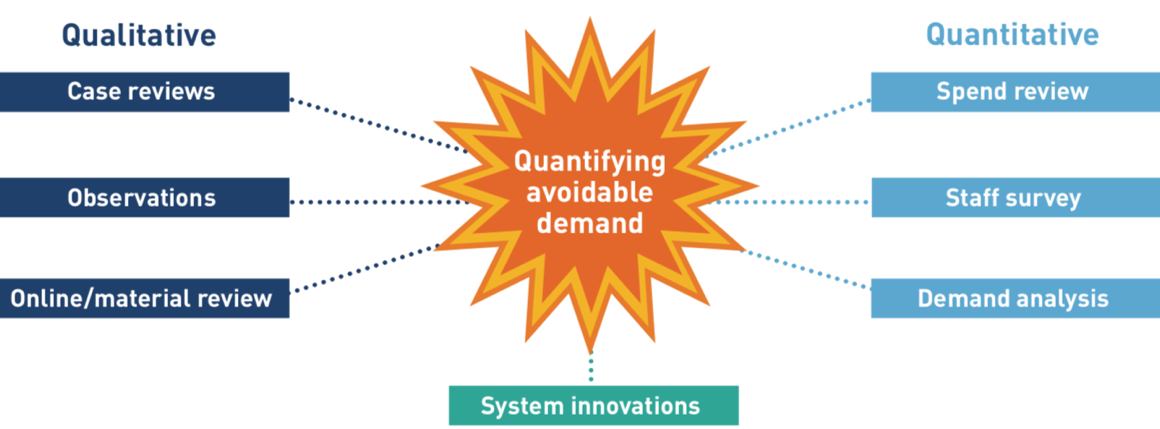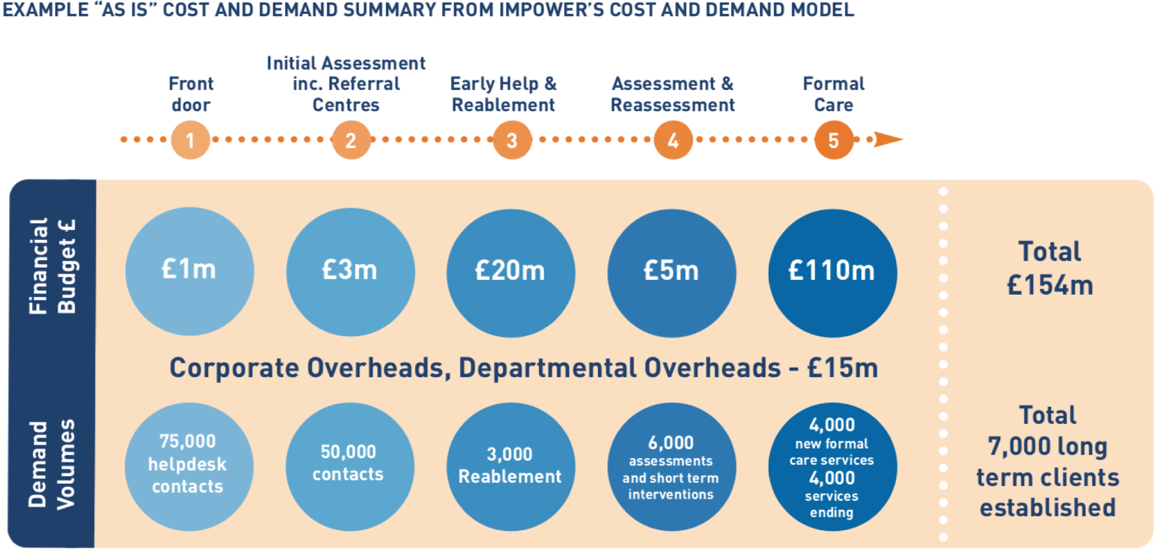Relieving pressure on acute beds and improving outcomes in Lincolnshire
Relieving pressure on acute beds and improving outcomes in…

How to save £3 billion and promote independence in adult social care
Of the £14 billion spent on adult social care each year, some £3 billion is spent on unnecessary care – and could be saved if the system was better organised.
If those working in the sector set an inclusive ambition to take every opportunity to promote independence, we could spend £3 billion less and improve the outcomes for people. We call this ‘managing avoidable demand’.
To be clear, we are not saying that adult social care is inefficient, that the situation is the same in each council, or that £3 billion is a savings target that we should aim for. Cuts to adult social care are damaging and there are increasing levels of unmet need.
What we are saying is that we need to widen the lens that is usually taken to budget setting. Over previous decades, we have inadvertently created expectations, cultures, processes and systems that drive dependency – and therefore increase costs. This cannot continue.
Achieving the required step change in planning, organisation and culture is not easy, but it can be delivered through a focus on demand: a ‘Target Demand System’. While no local authorities have yet delivered a fully realised system of this kind, many of them are on the right path. Evidence from our work with numerous authorities shows that:
In 2011, only 25% of local government leaders surveyed by IMPOWER said that they had a heavy or significant focus on managing demand for services.1 By 2015, almost all leaders reported that this was now a priority – meaning that a central focus on demand management is now almost universally accepted as a top requirement.
Positively managing demand in adult social care has a specific meaning. It is about fundamentally changing our understanding of productivity in public services. By addressing citizens’ needs early on to prevent them from escalating, by empowering them to do more for themselves, and by building self-sufficient and resilient communities, individuals experience greater independence and better outcomes with less (or different) state intervention. This does not imply that demand is manipulated by shunting costs around between different parts of the system, or by reducing service levels. Rather, managing demand to the maximum extent is not only in the best interests of citizens, but will also deliver real savings.
Adult social care departments anticipate needing to make savings of some £824 million in 2017 alone. For some councils there are still unit-cost, internal staffing and efficiency savings to be found, although for most, the easy efficiencies and other simple interventions have long been exhausted. This paper argues that whilst an aging population is inevitable, equivalent growth in the demand for adult social care should not be inevitable. Most demand is influenceable – and a significant proportion of it could be avoided altogether.
Total net adult social care spend

In this paper, we refer to some concepts to which we attach specific meanings.
Services provided to, or costs incurred on behalf of, individuals that do not improve the outcome, and where the same or a better outcome could be delivered with different services or at lower cost. Avoidable demand is quantified in cash terms as the overall cost of the current service or intervention, net of the cost of any replacement service, if one exists.
Demand that could be changed in some way through being prevented, reduced or delayed. Only a proportion of it can be avoided altogether.
There are a number of opportunities along any individual’s unique customer journey where decisions or actions taken by the individual (or others) can significantly increase or decrease their independence. To model the overall financial impact, demand flows and intervention opportunities, we have summarised these moments into a number of key intervention points.
System interventions are ’test and learn’ prototypes designed to demonstrate measurable changes in demand flows at key intervention points. They are designed to be quickly implementable, generating quantitative and qualitative evidence of changed behaviours, and act as the first phase of wider roll out. They use behavioural science, as demand for public services is driven by people and their behaviour.
IMPOWER’s Target Demand System, which was developed through our work with ten councils, enables local authorities to ensure that demand is appropriately managed at every step of the customer journey.
It is based on the premise that, once we take demand as the key factor in reducing cost and improving outcomes, we require a new set of tools for understanding and delivering adult social care – including a performance management approach. For further background, we recommend Professor John Bolton’s discussion paper, ‘Predicting and managing demand in social care’
The Target Demand System brings together a range of quantitative and qualitative approaches:


In this paper, we focus on four of these analysis streams.
We observed more than 300 hours of conversations between staff, customers, families and carers at six different councils. Such observations gave us first-hand insight into the language, behaviours and interactions that can directly and indirectly drive demand. From our analysis, we:
Insights from observations provide themes for improvement activities as well as specific examples of dependence creation. Examples include:
The most positive approach to demonstrating avoidable demand in the system is through a ‘test and learn’ approach. We have drawn evidence from system interventions in seven councils across each key intervention point, including: helpdesk and front door; pre- assessment and assessment conversations; short term support planning; and review and reassessment. Each system intervention varied in scope and scale, with one covering 22,500 customer interactions in three months.
Adult social care helpdesk interventions typically focus on increasing the proportion of queries resolved at the initial contact stage through expert engagement, high quality signposting, strengths-based questioning, and innovative problem solving. In one council, introducing a behavioural science-led training programme and toolkit increased the resolution rate at this stage in the customer journey by up to 18%. In another council, staff assessed that had they already implemented the revised approach, some 47% of client contacts would have had a different outcome.
Where there has been a focus on changing the initial conversation with new entrants to the social care system, there has been a 50% reduction in the number of people requiring a needs assessment. Instead of formal assessment, these individuals have been directed towards community initiatives and preventative services, which both promoted their independence and reduced the cost to the council.
By setting up reviews and reassessments as a different type of conversation which focuses on identifying the desired outcome and then flexibly planning to meet it, this system intervention led to a social worker-reported shift in outcome in 84% of new cases , and 36% of cases reviewed.
IMPOWER’s cost and demand tool consolidates cost, volume, performance and outcome data from multiple systems across ten councils. This allows a demand-led analysis of current service cost and demand, thereby highlighting the shifts in demand which occur at each intervention point in the customer journey. Where data is available this can be broken down by cohort, to provide specific insights into demand pinch points and cohort-specific challenges.
Once as-is cost and demand flows are established (as in the example on page 13), the next step is to develop ‘to-be’ scenarios based on demand shifts at each intervention point in the customer journey. This is best done by combining a top-down exercise (to illustrate, for example, what a 20% budget reduction would look like, and the consequent demand shifts that would be required) and a bottom-up approach (to help target and quantify the impact of current and planned projects and other savings activity throughout the customer journey).

Joint scenario-planning discussions between service leads, finance leads and project or transformation leads can make use of adjustable scenario tools like the one shown below. Their use can lead to much more creative and realistic savings planning than traditional budget setting exercises.
Insights from the cost and demand model help to prioritise avoidable demand activity, whilst also setting clear targets which can measured throughout delivery.

We also collated evidence from 300 case reviews across eight different councils. Our approach centred on a structured set of questions designed to identify whether all opportunities to maximise a person’s independence had been taken as they progressed through the customer journey. This exercise was led by social care staff themselves, supported by multi-disciplinary professionals from adult social care and health.
Each case was evaluated and challenged to see if all options were taken to promote independence and improve wellbeing, which could have resulted in preventing or delaying entry into the social care system, or in reducing the support required from the council to assist the person to achieve their desired outcomes and meet their needs.
The specific cohorts that were chosen, as well as variance in local conditions, made it inevitable that results were varied. However, we consistently found that practitioners assessed that:

Note: in many cases there was potential for a combination of results; these then appear in two of the categories or in all three. Overall, there was potential to influence demand in 70% of cases by at least one of the three areas of preventing, delaying or reducing need.
These missed opportunities occur throughout the customer journey, with the top three intervention points at:
Our calculation is that 70% of demand is influenceable, and that 20% of demand could be avoided altogether. Therefore, of the total £14 billion spent on adult social care annually, £3 billion is spent unnecessarily.
of demand could be avoided altogether
Council budgets continue to bear immense pressure. The savings from identifying easy efficiencies and other simple interventions have long been exhausted. Across the country, councils are having to make all kinds of new and difficult decisions on cuts and reductions in services.
There is no doubt that adult social care is underfunded. A new national settlement – as promised in the upcoming Green Paper – is urgently needed.
There is, however, another opportunity available: managing avoidable demand. This is an approach which can not only save £3 billion, but can also improve outcomes at the same time. Many councils are on the right journey towards delivering a fully-functioning Target Demand System, and the available evidence suggests that this approach will deliver the desired results in the coming months and years.
Managing avoidable demand has a few prerequisites.
It requires some new tools. It requires Chief Executives and Finance Directors to work with their Directors of Adults Services, along with health partners and others in the adult care ecosystem to agree a bold and inclusive ambition. And it requires a different approach to
setting budgets.
Read more related content from across the site, including in-depth reports, project case studies and articles.